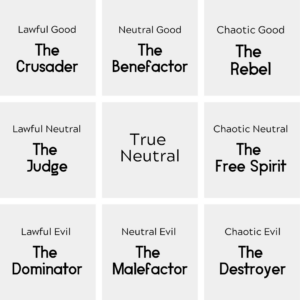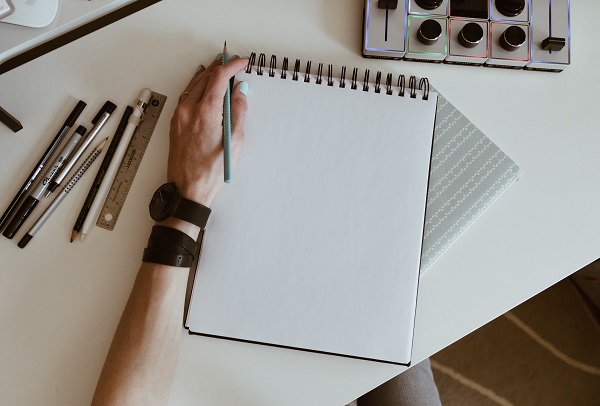Every good book has a strong cast of captivating characters accompanying the reader throughout the story. Whether it’s high-action fantasy, gritty crime drama or heart-wrenching romance, characters who are realistic and relatable are integral to an interesting read.
So, you’ve done your research into how to master character creation. You know you need to create compelling backstories, delve into character flaws, and explore character motivations, in addition to crafting the physical descriptors necessary for the reader to imagine them. Some writers are lucky enough to be able to conjure such things out of nowhere; others need a helping hand.
As such, we’ve put together a list of some of the most creative and enjoyable ways to get to know your characters. Let’s take a look!
Method #1: Try Character Quizzes or Interviews
People are complex creatures. Sometimes we only discover things about ourselves when confronted with a difficult question or situation. Because of this, there’s no shortage of character questionnaires and quizzes available online – 2.9 billion hits, in fact, according to Google.
Any one of the first-page results will provide you with a detailed stepping stone to crafting your character, covering everything from family to fears to physical descriptions.
These rapid-fire short form answers are a great starting point and convenient way to keep track of basic information that can easily be forgotten. But these sort of records don’t work for every writer. Some (myself included) find the process boring and the details generated a little superficial.
That’s not to say quizzes and interviews are not without merit; some writers just need to dig a little deeper.

Searching for unusual and unique character development questions on websites such as Tumblr or Pinterest can help unearth some juicer material to really give your character some spice. For an added kick, consider framing otherwise irrelevant questions (such as a favourite movie or music genre for characters in a fantasy world) in an AU (alternate universe) setting.
While knowing that your princess protagonist is a heavy metal-listening, horror-movie-binge-watching badass in another life will never be mentioned in the context of your fantasy novel, these details can still have surprising effects. Maybe she rolls her eyes whenever the court orchestra plays, or takes midnight strolls through the graveyard when she can’t sleep. Maybe she wants to be kidnapped by the baddies so she can fight her own way out.
Another way to get a little more creative with this type of character building is to answer the questions as the character. Not only is this a whole lot more fun than providing one- or two-word answers, it also provides you with a fantastic opportunity to practise and develop the character’s voice.
Show, don’t tell, right?
Method #2: Assign Your Character A Personality Type
Psychologists have put a lot of work in over the years mapping out the distinct personality types to which people comply. This real-world research is a fantastic tool you can use when crafting believable characters.
The Myers-Briggs Type Indication (MBTI), while largely considered pseudoscience, is one of the most well-known and easily understood personality model. This four-letter ‘code’ shows one’s preference between Extroversion/Introversion, Sensing/Intuition, Thinking/Feeling, and Judging/Perceiving.
The MBTI, as explained by 16 Personalities, recognises 16 distinct personalities that are grouped into four larger categories:
- Analysts
- INTJ ‘The Architect’ – Imaginative and strategic planners
- INTP ‘The Logician’ – Knowledge-seeking innovators
- ENTJ ‘The Commander’ – Bold, strong-willed leaders
- ENTP ‘The Debater’ – Smart, challenge-driven thinkers
- Diplomats
- INFJ ‘The Advocate’ – Quiet and inspiring idealists
- INFP ‘The Mediator’ – Poetic, kind and altruistic
- ENFJ ‘The Protagonist’ – Charismatic and inspiring leaders
- ENFP ‘The Campaigner’ – Free-spirited, sociable creatives
- Sentinels
- ISTJ ‘The Logistician’ – Reliable, practical and fact-minded
- ISFJ ‘The Defender’ – Dedicated and warm protectors
- ESTJ ‘The Executive’ – Excellent people managers
- ESFJ ‘The Consul’ – Popular, social and extraordinarily caring
- Explorers
- ISTP ‘The Virtuoso’ – Bold, practical experimenters
- ISFP ‘The Adventurer’ – Flexible, charming artists
- ESTP ‘The Entrepreneur’ – Smart, energetic and perceptive risk-takers
- ESFP ‘The Entertainer’ – Spontaneous and enthusiastic party-makers
In addition to far more detailed descriptions, including examples of each personality type featuring both real and fictitious people, you can also take their free indicator test. Have some fun and try a bit of role-playing by answering as your characters to get their individual assessment.
Another option is to look up an alignment chart to ascertain your characters’ moral compasses. Originally related to the tabletop RPG Dungeons and Dragons, in more recent years the alignment chart has been used across genre and media.
The alignment chart explores where a person best fits between Good and Evil, Lawful and Chaotic, and is most simply represented in a 3×3 grid.

Unlike the MBTI, these titles are quite self-explanatory and can probably be assigned to your cast without further investigation. However, if you’re looking at getting into the intricacies of these moral types, Geek & Sundry has an easy-to-read breakdown of each alignment, complete with well-known examples from popular culture.
If the morality of your character is still ambiguous, you can always take an online alignment test. As the tests were originally used for designing D&D characters, they tend to be medieval/fantastical in nature, so fantasy fiction writers may find them particularly useful.
Method #3: Create a Mood or Aesthetic Board For Your Character
Sometimes words are hard.
If you’re struck down by writer’s block or just can’t seem to find that thing that makes your character pop off the page, then maybe it’s time to look at different creative mediums.
Great writing engages all five senses; great inspiration comes from the world around us. While you might not have time to sit crowd-watching and studying the mannerisms or unique physical traits of people passing by, you can tap into a wealth of resources thanks to the internet.
Aesthetic and mood boards are a great visual means of capturing the essence of your character without having to write a single word. Visual boards can inspire, motivate and provide you with something pretty and intriguing to share with your social network if you’re going down the indie publishing path.

Creating visual stimuli can help tease out the facets of your character you wish to highlight, even if some aspects of their personality are still a little vague. Is there a colour palette that resonates strongly with their personality? An animal or physical location?
Graphic design website Canva has over 50,000 templates for you to use and edit – all for free. Even if you have zero design talent or experience, you can put together visually pleasing boards using their huge range of stock images.
If collages aren’t your thing, Pinterest is a great source of all things aesthetic. Successful YA authors Sarah J. Maas, Leigh Bardugo and Maggie Stiefvater all have public boards showcasing collections of inspiration for their novels, ranging from locations to fashion to abstract, moody aesthetics.
Having a solid understanding of your character’s physical location can inform their personality and backstory more than you realise. Perhaps images of sprawling plains inspire flashes of a childhood spent playing with friends, or a broken window evokes a long-buried trauma.
While perusing Pinterest and its never-ending feed of suggested ‘pins’ may feel like Grade A procrastination, if it helps fill in the blanks of your character-creation canvas, then go ahead and scroll.
Method #4: Write Short Stories About Your Character
Building on from visual inspiration, and the character history it may inspire, is the act of sitting down and actually writing that backstory. If writing dot-point timelines is your thing, then don’t let me stop you – but why not try putting a more creative spin on things?
While you might be hesitant to devote precious writing time and words on something that isn’t your novel, writing short stories about a character’s past or exploits outside the confines of the main narrative can be equally beneficial.
We’re all shaped by our pasts, both consciously and subconsciously. Do you remember when you were seven? Chances are, you do. What about your character? What were they doing at that age? Was there another monumental, character-defining event in their past?
You don’t need to write a history tome or even great literature – this can just be a fun little exercise. (Though if you are willing to spend some more time on the endeavour, short stories like these make great promotional tools for indie authors.)

Working in short, timed bursts where you put your creative mind on the spot can produce some unique and compelling ideas. Writing impulsively can also help avoid character backstories being overthought and feeling contrived.
If you’re still working out the kinks in your characters mannerisms, working with random prompts can also help smooth our your ideas. Tumblr and Twitter are great sources for writing prompts, and there are also plenty of writing prompt apps available.
Putting your character in unusual situations, however unlikely they are to occur in your novel (such as a character reacting to finding a gun in their mailbox when you’re writing medieval fantasy fiction), is a fun and refreshing way to develop your character – and help you push past writer’s block if you’re stuck with your main narrative.
Reactions are universal and developing the way your character responds to danger will be the same, regardless of whether they are faced with a gun-blazing bank robber or a roaring plague demon.
At the end of the day, every word you write is strengthening your craft.
Method #5: Design The Character
Now you’ve written lengthy character bios, given them a host of attributes and flaws, and cultivated a compelling backstory. But something’s still missing. Even if you’ve noted the character’s hair and eye colour, their height and weight, you still might not have a clear picture of what they look like.
Physically designing a character can be hugely cathartic if you’re suffering from writer’s block. Like mood boards and other visual inspiration, this can shed light on new aspects of your character.
Giving a character a certain hairstyle, for example, might reveal more about their personality. Is long hair too high-maintenance for them? Are they easily irritated and need to have hair pinned out of their eyes? Every little detail you decide to add – be it scars, tattoos or distinct clothing choice – all work to build a history of your character.
Not everyone is an artist. But even if you’re hopeless with a sketchpad that doesn’t mean you can’t have some fun with character design.

If you want to develop your drawing skills, online skills websites such as Udemy and Skillshare have a range of courses in character design, and of course there are numerous tutorials on YouTube. If you’re a tablet user, both Apple and Android have a number of drawing apps available for free to give you an extra hand as well.
As with writing exercises, you don’t need to produce share-worthy artwork: the purpose is to tap into a different vein of creativity to help bolster your character development. However, if the thought of shoddy stick figures is too cringe-worthy to bear, online avatar creators have got you covered.
If you’re a millennial who survived the days of Netscape and dial-up internet like myself, you might have spent hours playing dress ups with the pixel princesses of Dollz Mania. Back in the day, these dolls were 16-bit sprites reminiscent of Super Nintendo graphics; now there is a huge range in a number of styles pretty much catering for all genres and aesthetics.
Azalea’s Dolls, Doll Divine and Rinmaru Games all have a fantastic selection of designers at their disposal. These games are all free to play and, after installing Flash and sitting through the odd ad or two, you’re left to your own creative devices.
Of course, you are limited by the customisation options available (and some games are more detailed than others, so you might need to shop around), but it’s a great alternative to drawing your own. Just don’t get too addicted!
***
In order to create compelling characters, sometimes you need to do more than write. Taking a step away from your novel and getting to know your characters inside and out through different creative outlets can be a hugely beneficial, not to mention fun, way to explore what makes them tick.
Whether you’re completing character personality quizzes, writing short stories or getting visually creative with mood boards or character design, just enjoy the process.
You may uncover more about your brain-babies than you thought.